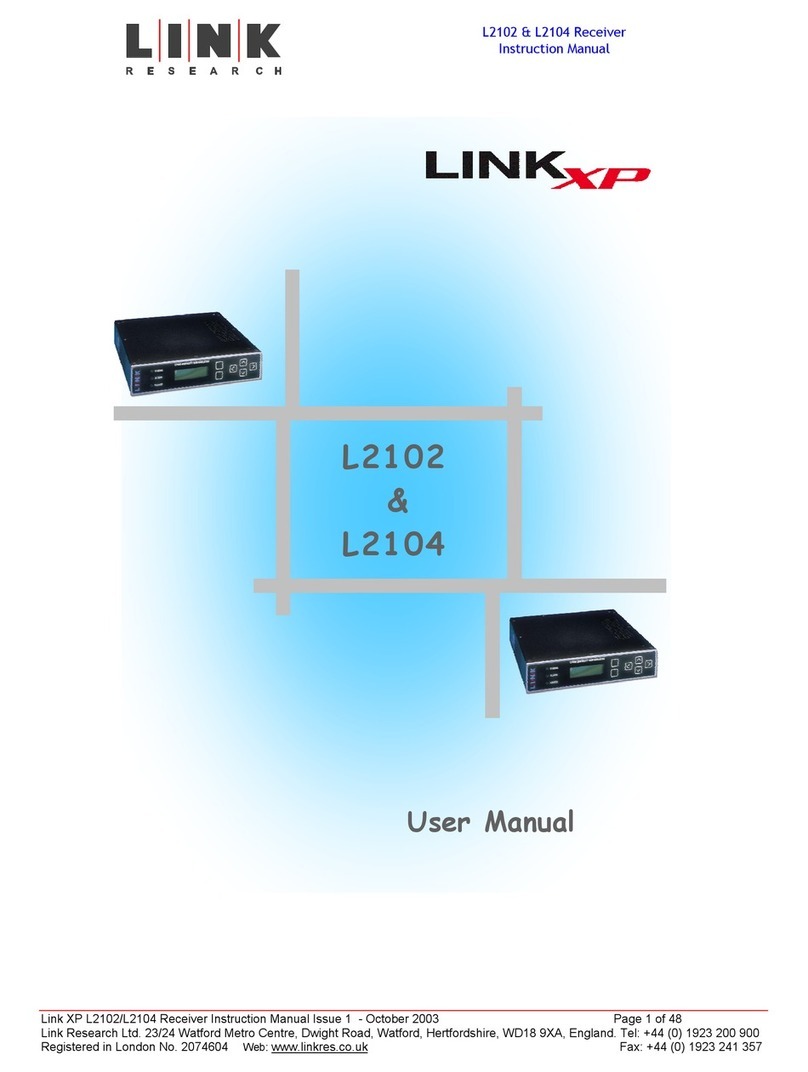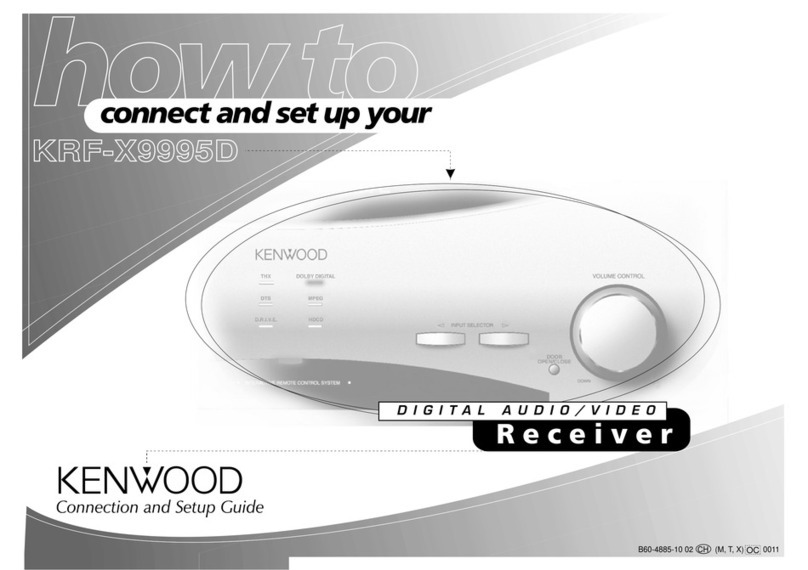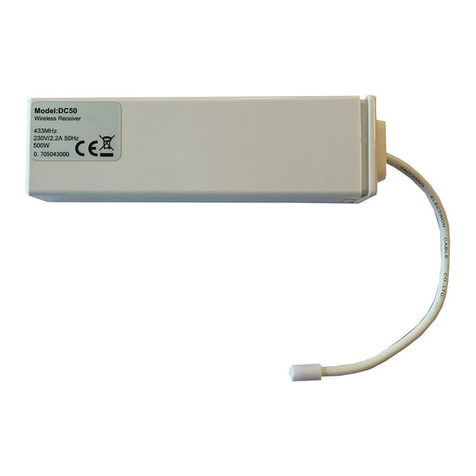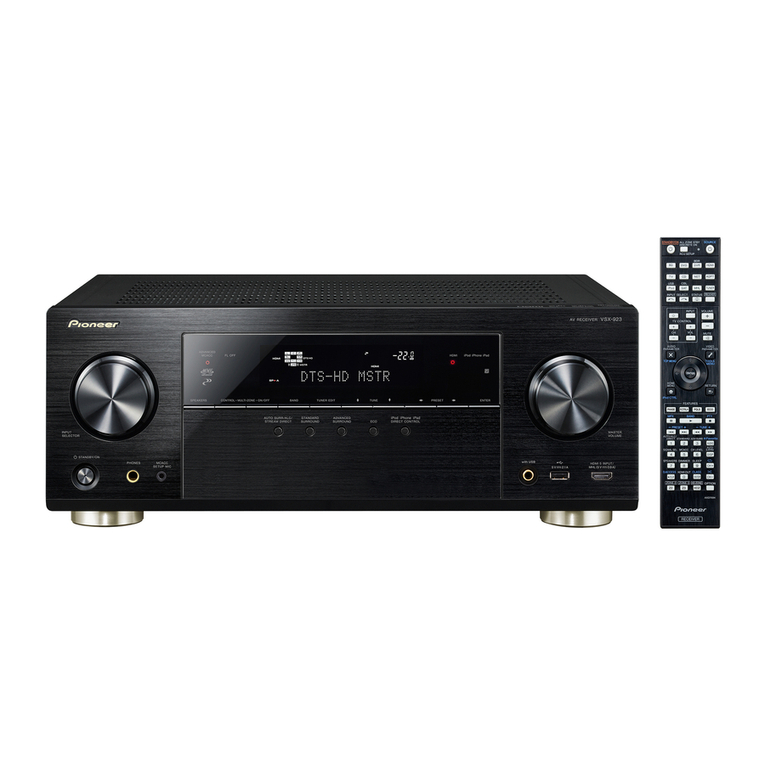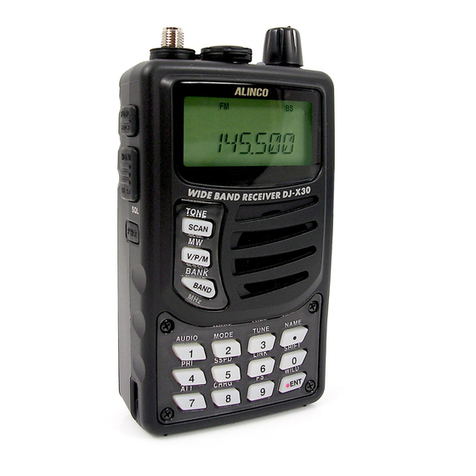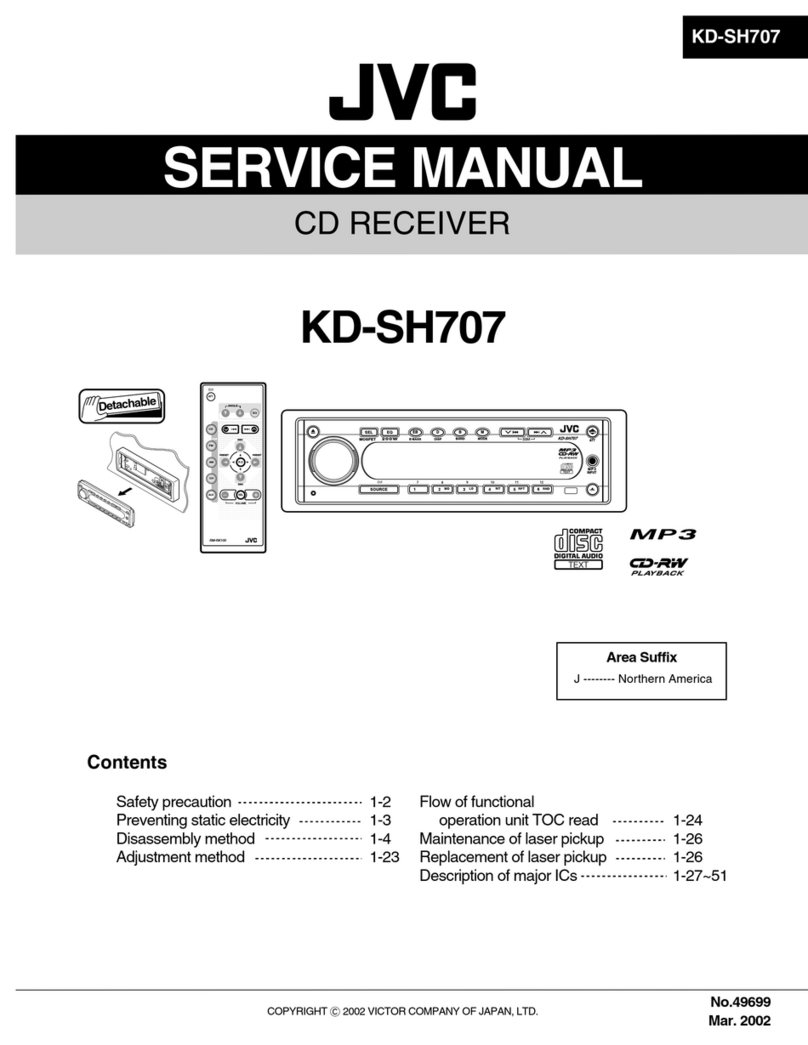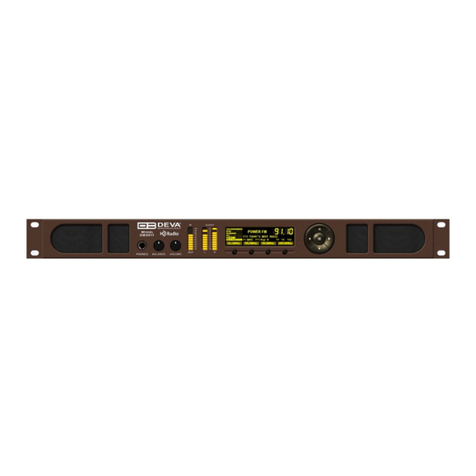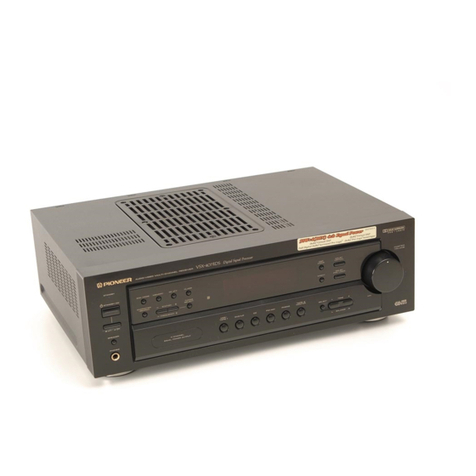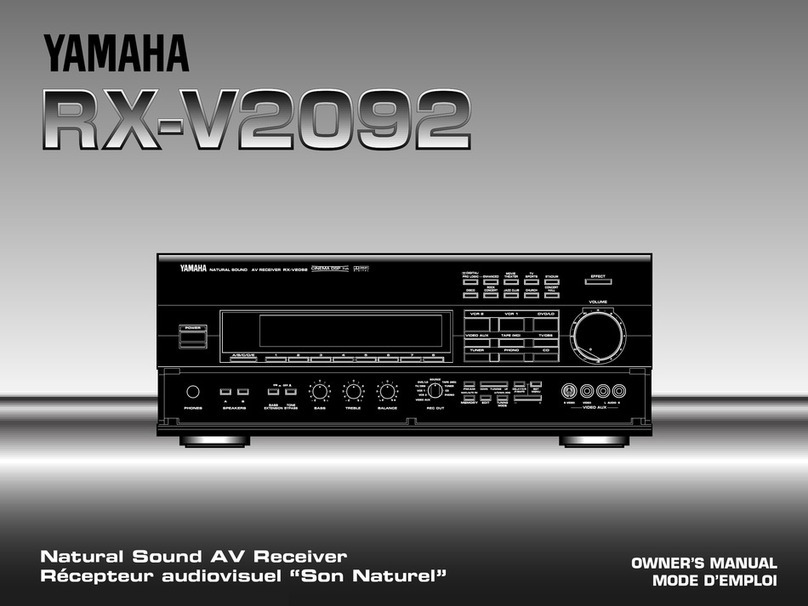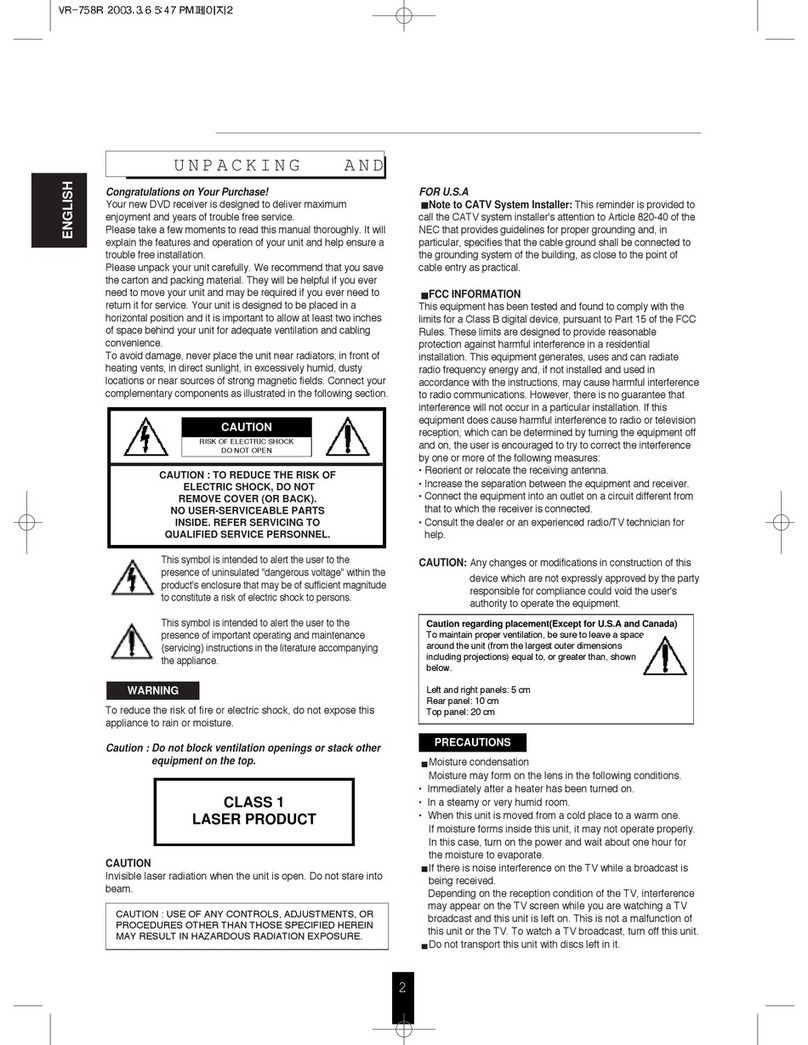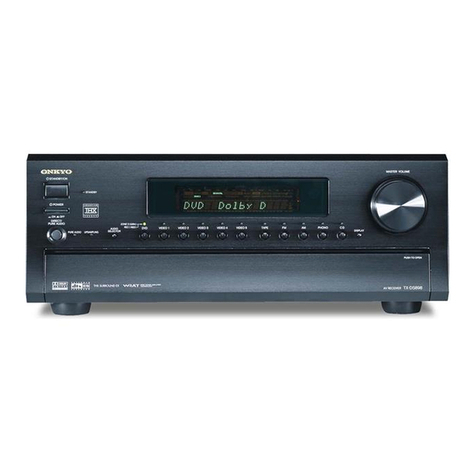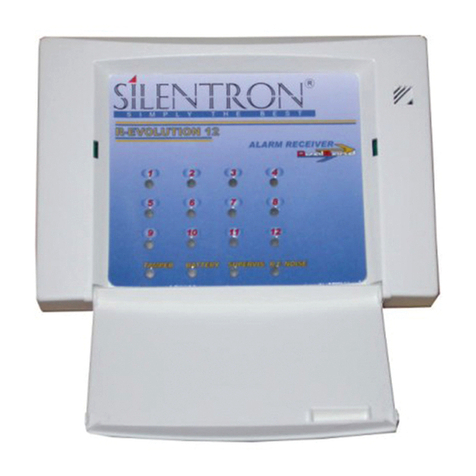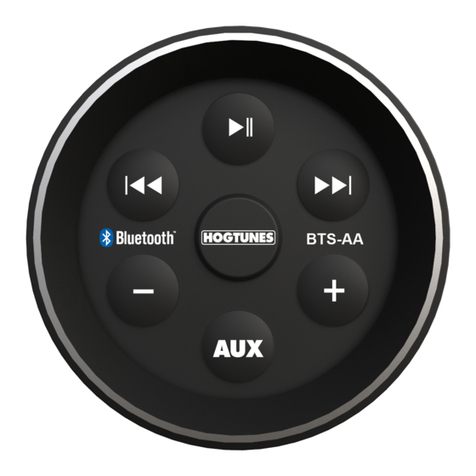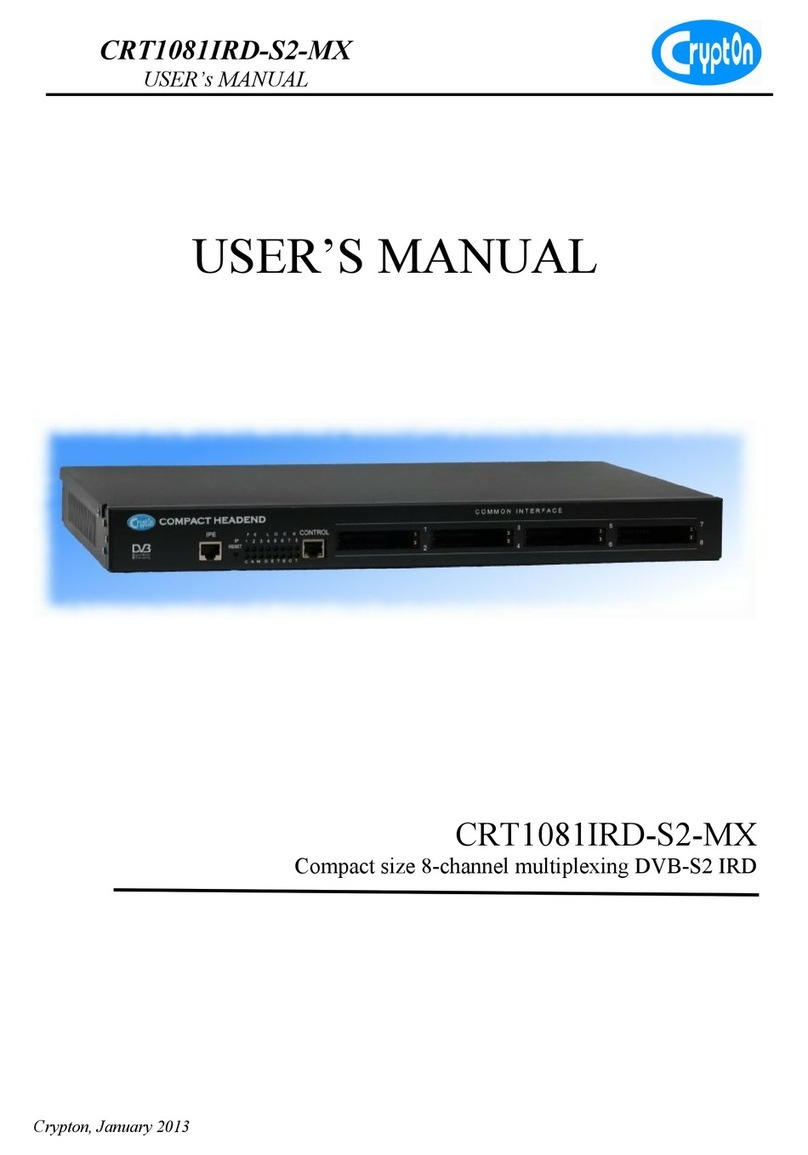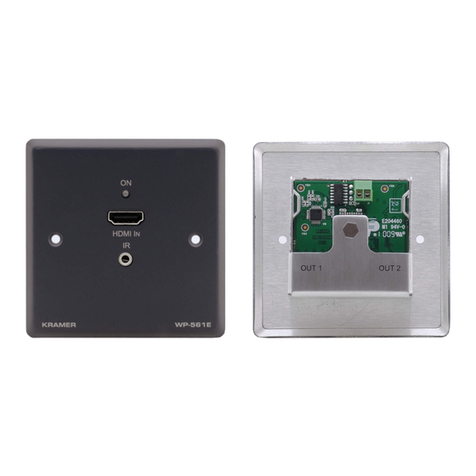Link Research L2201 User manual

L2101 &L2102 Integrated Receiver Decoder Instruction Manual – Issue 1 – September 2003 Page i of 126
Link Research Ltd. 23 Watford Metro Centre, Dwight Road, Watford, Hertfordshire, WD18 9XA, England.
Tel: +44 (0) 1923 200 900 Customer Support and Service +44 (0) 1923 200 909
Registered in London No. 2074604 Web: www.linkres.co.uk Fax: +44 (0) 1923 241 357
User Manual
L2201
&
L2202

L2101 &L2102 Integrated Receiver Decoder Instruction Manual – Issue 1 – September 2003 Page ii of 126
Link Research Ltd. 23 Watford Metro Centre, Dwight Road, Watford, Hertfordshire, WD18 9XA, England.
Tel: +44 (0) 1923 200 900 Customer Support and Service +44 (0) 1923 200 909
Registered in London No. 2074604 Web: www.linkres.co.uk Fax: +44 (0) 1923 241 357
INTRODUCTION
L2201 AND L2202 INTEGRATED RECEIVER DECODER
MANUAL SCOPE AND STRUCTURE
The User Manual for the L2201 and L2202 Integrated Receiver Decoders is comprised of
four main sections:
OVERVIEW:
This section provides introduction and product description, including highlights,
benefits and typical applications, gives a functional and physical description of the
unit and lists its main capabilities and specifications.
INSTALLATION:
This section provides data and procedures required to install and activate the unit.
Procedures include site preparation and requirements, installation in a 19" rack, cable
connections, panel options and Pin-out descriptions, initial settings and serviceability
check.
OPERATION:
This section provides theoretical background on the operation of the unit, and gives
data and instructions on using the unit and operating the control and monitoring
functions provided to the user.
MAINTENACE
It is assumed throughout this document that personnel have a general knowledge about
the L2201 and L2202 Integrated Receiver Decoders, application and capabilities.

L2101 &L2102 Integrated Receiver Decoder Instruction Manual – Issue 1 – September 2003 Page iii of 126
Link Research Ltd. 23 Watford Metro Centre, Dwight Road, Watford, Hertfordshire, WD18 9XA, England.
Tel: +44 (0) 1923 200 900 Customer Support and Service +44 (0) 1923 200 909
Registered in London No. 2074604 Web: www.linkres.co.uk Fax: +44 (0) 1923 241 357
After sales support
In all support requirements or in case of unit failure please contact Link Research directly (contact
details at the foot of this page). Always refer to the Link Research web site for firmware upgrades,
interoperability and support in general.
Standard warranty cover
The L2101/L2102 Integrated Receiver Decoder is fully covered for parts and labour in case of failure
for one year from date of despatch from Link Research Ltd.
In addition an advance replacement service is included for the first year, see below.
Extended warranty and advance replacement are available beyond the first year; contact Link
Research for details.
Repair procedure
If the unit has failed please contact Link to be given a RAN number (Return Authorisation Number).
Wherever possible please give a full description of the problem leading to the failure.
Return the unit to Link Research at the address given, preferably in the original packaging and
enclosing a full fault report wherever possible. The unit will be repaired and returned as soon as
possible. Repair times should be short but if you must have a replacement unit immediately then
you can take advantage of our advance replacement service.
Advance replacement service
On request, once the fault has been discussed with a Link technician and a RAN number allocated,
Link Research will despatch a temporary replacement unit within 24 hours of your call. The
replacement unit must be returned on receipt of your repaired unit complete with the original
packaging.
N.B. For repairs and advance replacement units, shipping costs will be borne by Link Research for
the outward leg only.
For out-of-the box failures, occurring within the first 14 days from delivery, Link Research will pay
agreed transport costs in both directions.
CE Certification
Both L2201 and L2202 meet all the CE Class B requirements with the exception of
Emission Requirements.
In order to meet CE requirements, the following cables must be connected on all ASI
outputs (ASI out 1, ASI out 2, ASI out 3). When cables are connected to these outputs
then the device is compliant with FAIR-RITE 0443164151.

L2101 &L2102 Integrated Receiver Decoder Instruction Manual – Issue 1 – September 2003 Page iv of 126
Link Research Ltd. 23 Watford Metro Centre, Dwight Road, Watford, Hertfordshire, WD18 9XA, England.
Tel: +44 (0) 1923 200 900 Customer Support and Service +44 (0) 1923 200 909
Registered in London No. 2074604 Web: www.linkres.co.uk Fax: +44 (0) 1923 241 357
FCC Compliance Notice
Trade Name Link Research
Product Name Integrated Receiver Decoder
Product Model Number L2201
Product Model Number L2202
These devices comply with Part 15 of the FCC Rules.
Operation is subject to the following two conditions:
1. This device may not cause harmful interference.
2. This device must accept any interference received, including interference that may
cause undesired operation.
Responsible Party's Name Roger Davies
Address Link Research Ltd
23 Watford Metro Centre
Dwight Road
Watford
Herts
WD18 9XA
United Kingdom
Responsible Party's Telephone +44 1923 200900
The FCC Wants You to Know
This equipment has been tested and found to comply with the limits for a Class B digital
device, pursuant to Part 15 of the FCC rules. These limits are designed to Provide
reasonable protection against harmful interference in a residential installation. This
equipment generates, uses and can radiate radio frequency energy and, If not installed and
used in accordance with the instructions, may cause harmful interference to radio
communications.
However, there is no guarantee that interference will not occur in a particular installation. If
this equipment does cause harmful interference to radio or television reception, which can
be determined by turning the equipment off end on, the user is encouraged to try to correct
the interference by one or more of the following measures:
Reorient or relocate the receiving antenna.
Increase the separation between the equipment and receiver.
Connect the equipment to an outlet on a circuit different from that to which the receiver is
connected.
Consult the dealer or an experienced radio/TV technician.
FCC Warning
Modifications not expressly approved by the manufacturer could void the user authority to
operate the equipment under FCC Rules.

L2101 &L2102 Integrated Receiver Decoder Instruction Manual – Issue 1 – September 2003 Page v of 126
Link Research Ltd. 23 Watford Metro Centre, Dwight Road, Watford, Hertfordshire, WD18 9XA, England.
Tel: +44 (0) 1923 200 900 Customer Support and Service +44 (0) 1923 200 909
Registered in London No. 2074604 Web: www.linkres.co.uk Fax: +44 (0) 1923 241 357
TABLE OF CONTENTS
Standard warranty cover............................................................................................iii
Repair procedure.......................................................................................................iii
Advance replacement service....................................................................................iii
1. Overview .................................................................................................................................. 9
1.1 General Information ............................................................................................ 9
1.2 Highlights and Benefits ....................................................................................... 9
1.3 Inputs ....................................................................................................... 10
1.4 Outputs............................................................................................................. 11
1.5 Conditional Access ........................................................................................... 11
1.6 Control And Monitoring ..................................................................................... 12
1.7 Applications ...................................................................................................... 12
1.8 Broadcast Redistribution................................................................................... 13
1.9 Stand Alone Decoder........................................................................................ 13
1.10 Internal Corporate Distribution ........................................................................ 13
1.11 Data Transfer.................................................................................................. 13
1.12 Low Speed Data ............................................................................................. 14
1.13 High Speed Data ............................................................................................ 14
1.14 Descrambling.................................................................................................. 14
Functional Description ............................................................................................................ 15
1.15 L2201 and L2202 Block Diagram.................................................................... 15
1.16 Basic Configuration......................................................................................... 15
1.17 Receiver Front End Options............................................................................ 16
1.18 Configuration Options ..................................................................................... 17
2Mechanical Structure............................................................................................... 18
2.1 Enclosure ................................................................................................. 18
2.2 Front Panel............................................................................................... 18
2.3 Rear Panel ............................................................................................... 18
3Management ........................................................................................................... 20
3.1 Front Panel Control .................................................................................. 20
3.2 Infrared Remote Control ........................................................................... 20
3.3 PC Terminal Control ................................................................................. 20
4Characteristics and Specifications ........................................................................... 21
4.1 Receiver Input Specifications ................................................................... 21
4.2 Output Specifications................................................................................ 23
4.3 Control Ports Specifications...................................................................... 24
4.4 Physical Features and Specifications ....................................................... 25
5 Installation........................................................................................................................................ 26
5.1 Introduction....................................................................................................................... 26
5.2 Safety Precautions ................................................................................... 26
5.3 Inventory Check ....................................................................................... 26
5.4 Site Preparation....................................................................................................... 27
5.5 Installation ............................................................................................................... 27
5.5.1 Installation in 19" Rack ............................................................................. 27
5.5.2 Insertion of the DVB-CI Module (PCMCIA)............................................... 28
5.6 Cable Connections .................................................................................................. 29
5.6.1 L2201 and L2202 Connection Setup and Options .................................... 29
5.6.2 Front End Panels...................................................................................... 30
5.6.3 Decoder Cable Connections..................................................................... 30
5.6.4 Terminal Control and Data Connections................................................... 30
5.6.5 Power Connection .................................................................................... 31
Ground Connection .................................................................................. 31
AC Power Connector................................................................................ 32
DC Power Connector................................................................................ 32

L2101 &L2102 Integrated Receiver Decoder Instruction Manual – Issue 1 – September 2003 Page vi of 126
Link Research Ltd. 23 Watford Metro Centre, Dwight Road, Watford, Hertfordshire, WD18 9XA, England.
Tel: +44 (0) 1923 200 900 Customer Support and Service +44 (0) 1923 200 909
Registered in London No. 2074604 Web: www.linkres.co.uk Fax: +44 (0) 1923 241 357
5.7 System Expansion................................................................................................... 33
5.7.1 Cascade Loopthrough Output................................................................... 33
5.7.2 ASI Loopthrough Cascade ....................................................................... 33
5.7.3 RS-485 Master-Slave Connection ............................................................ 34
5.8 Initialization And Configuration ................................................................................ 35
5.8.1 Powering Up............................................................................................. 35
5.8.2 Initialization Sequence.............................................................................. 35
5.8.3 Serviceability Check ................................................................................. 38
6 Operation ......................................................................................................................................... 39
6.1 Introduction....................................................................................................................... 39
6.1.1 IRD Operation and Management.............................................................. 39
6.1.2 Front Control Panel ......................................................................... 40
6.1.3 Infrared Remote Control (Optional).................................................. 41
6.2 Four Way Touch Pad.......................................................................... 43
6.3 Front Panel Common Main Menu Options................................................ 44
6.4 Configuration Menu ................................................................................................. 46
6.5 Configuration / Receiver Menu ................................................................. 47
6.5.1 Configuration / Decoder Menu.................................................................. 53
Decoder / Stream Configuration Sub-Menu.............................................. 55
6.5 Decoder/CI Configuration Sub-Menu.................................................. 58
6.6 Decoder / Video Configuration Sub-Menu .......................................... 59
6.7 Decoder / Audio Configuration Sub-Menu .......................................... 62
6.8 Configuration/System Menu ..................................................................... 64
6.9 Status Menu ............................................................................................................ 68
6.9.1 Status / Receiver Menu ............................................................................ 69
6.9.2 Status / Decoder Menu............................................................................. 73
6.10 Decoder / Stream Status Sub-Menu ................................................. 75
6.11 Decoder / CI Status Sub-Menu......................................................... 78
Decoder / Video Status Sub-Menu ........................................................... 80
6.12 Decoder / Audio Status Sub-Menu ................................................... 82
6.12 Status / System Menu .............................................................................. 84
6.13 Test Menu ............................................................................................................... 84
6.14 Run Menu................................................................................................................ 87
6.15 Run / Service Menu.................................................................................. 88
6.16 Run / PID Menu........................................................................................ 91
6.17 Mode Run Menu....................................................................................... 93
6.18 Advance Run Menu .................................................................................. 96
6.19 Graphics Configuration (GFX-CNFG) Sub-Menu.............................. 97
Graphics Display (GFX-DSPL) Sub-Menu.............................................. 100
6.19 Other Advance Run Sub-Menu....................................................... 106
7 Maintenance................................................................................................................................... 107
7.1 General........................................................................................................................... 107
7.2 Safety Instructions ................................................................................................. 107
7.2.1 Safety Precautions ................................................................................. 107
7.2.2 Caution and Warning Statements........................................................... 107
7.3 Test Procedures .................................................................................................... 108
7.3.1 Power-Up Check. ................................................................................... 108
7.3.2 Maintenance Check Serviceability Check............................................... 108
7.3.3 Audio/Video Stream Test........................................................................ 108
7.4 Common Status Messages.................................................................................... 109
7.4.1 General Status Messages ...................................................................... 109
7.4.2 Hardware Failure Messages................................................................... 110
7.4.3 BIT Stream Warning Messages.............................................................. 111
7.4.4 Service Warning Messages.................................................................... 112
Appendix A. Appendix 1: Operational Menu Trees ................................................................... 122
Appendix B. Appendix B: LNB Theory Of Operation................................................................. 123

L2101 &L2102 Integrated Receiver Decoder Instruction Manual – Issue 1 – September 2003 Page vii of 126
Link Research Ltd. 23 Watford Metro Centre, Dwight Road, Watford, Hertfordshire, WD18 9XA, England.
Tel: +44 (0) 1923 200 900 Customer Support and Service +44 (0) 1923 200 909
Registered in London No. 2074604 Web: www.linkres.co.uk Fax: +44 (0) 1923 241 357
B.1 Why is an LNB needed? ....................................................................................................... 123
B.3 Frequency Calculation IRD + LNB ........................................................................................ 123
B.4 Use of a Splitter or Distribution (band) Amplifier ................................................................... 124
B.5 Calculating the L-Band Frequency........................................................................................ 125
D.1 Calculating Symbol Rate ...................................................................................................... 126


L2101 &L2102 Integrated Receiver Decoder Instruction Manual – Issue 1 – September 2003 Page 9 of 126
Link Research Ltd. 23 Watford Metro Centre, Dwight Road, Watford, Hertfordshire, WD18 9XA, England.
Tel: +44 (0) 1923 200 900 Customer Support and Service +44 (0) 1923 200 909
Registered in London No. 2074604 Web: www.linkres.co.uk Fax: +44 (0) 1923 241 357
1. Overview
1.1 General Information
The L2201 and L2202 are a new generation of the 4:2:0 / 4:2:2 Integrated Receiver
Decoders. Both L2201 and L2202 are suitable for SCPC and MCPC 4:2:0 applications;
L2202 provides support for 4:2:2 applications as well. With DVB-CI (Common Interface)
decryption capabilities, the IRD 2600 and L2202 output high quality video, audio and data
for satellite, cable and telecom programme distribution. L2201 supports two stereo outputs
while L2202 supports up to three stereo outputs.
Both L2201 and L2202 contain a demultiplexer, MPEG-2 video and audio decoders, as well
as Data and VBI insertion functions.
Control and management can be obtained via the IRD front control panel, an optional
Infrared Remote Control, or an attached PC terminal.
Input and Output sections support variable modules for versatility of the L2201 and L2202.
Input of DVB-ASI transport Stream or RS-422 directly to the decoder, as well as ASI output
(optionally decrypted) and loopthrough is also supported. ASI TS and RS-422 can be
connected at the same time with the various front ends. The desired input is selected by
the user.
L2201 and L2202 - General View
1.2 Highlights and Benefits
The L2201 and L2202 Integrated Receiver Decoders provide the following benefits:
•DVB Common Interface (2 Slots), Supports de-scrambling of all leading CAMs
•On-board DVB descrambling with BISS Mode-1 and BISS-E (DSNG-CA) support.
•Extended Front/End Interface options
•High and Low Speed Data Outputs
•Advanced software control and monitoring of all IRD functions and capabilities.
The following sub-paragraphs detail the features, enhancements and options of the L2201
and L2202.

L2101 &L2102 Integrated Receiver Decoder Instruction Manual – Issue 1 – September 2003 Page 10 of 126
Link Research Ltd. 23 Watford Metro Centre, Dwight Road, Watford, Hertfordshire, WD18 9XA, England.
Tel: +44 (0) 1923 200 900 Customer Support and Service +44 (0) 1923 200 909
Registered in London No. 2074604 Web: www.linkres.co.uk Fax: +44 (0) 1923 241 357
1.3 Inputs
Decoder Inputs RS-422 Clock/Data Input
DVB-ASI with Loop-through (optional)
•Interface: Copper or Optical
•TS bit rate: up to 54 Mbps
Receiver Input Options DVB Satellite (QPSK) Front End
•Frequency range: 950 -2150 MHz
•Symbol rate range: 1 - 45 M Symbols/s
•L-Band RF input with LNB control and
Loop-through output
•
DVB DSNG (8PSK, 16QAM and QPSK) Front End
•Frequency Range: 950-2150 MHz
•Symbol rate Range: 1 -45 Msym/s
•2 L-Band inputs with LNB control

L2101 &L2102 Integrated Receiver Decoder Instruction Manual – Issue 1 – September 2003 Page 11 of 126
Link Research Ltd. 23 Watford Metro Centre, Dwight Road, Watford, Hertfordshire, WD18 9XA, England.
Tel: +44 (0) 1923 200 900 Customer Support and Service +44 (0) 1923 200 909
Registered in London No. 2074604 Web: www.linkres.co.uk Fax: +44 (0) 1923 241 357
1.4 Outputs
Video
•Analog video Interfaces: 2 composite, 1 S-Video
•Digital video Interfaces (optional):
2x SDI, with embedded VBI and up to 2 stereo
channels
•Video formats:
PAL-B/G/I/M/N/D, NTSC/SECAM L/B/G/K1
•Russian SECAM D/K (option applicable only in
composite video, available only for L2201).
•Decoding:
4:2:0MP@ML (1.5 -15 Mbps)
4:2:2PP@ML (1.5 -50 Mbps) (L2202)
•Video Resolution Interpolation:
Pan-Scan, Letter box or Pass-through
•Aspect ratio:4:3/16:9 and 14:9
•Graphic processing: OSD, DVB Subtitling,
EBU (Teletext) Subtitling.
•OSD only on monitoring output (optional)
•Sync Lock Input and Loopthrough output (optional)
•
VBI Re-Insertion
•In Composite video and embedded in SDI
•WST Teletext and inverted Teletext
•WSS, VPS, VITC, SMC, CC, AMOL (optional)
•Enhanced VITS with built-in generator
•
Audio
•Analog audio: up to 3 stereo pairs (up to 2 stereo
pairs in L2201). All inputs balanced or 1st
unbalanced (optional)
•Digital audio (optional): up to 3 AES/EBU-SPDIF
(up to 2 on L2201)
•Embedded in SDI (optional): up to 2 stereo
•Mode: Stereo, Joint Stereo, Dual Channel, Single
Channel
•Max output level: +24 dBu analog, 0 dBFs digital
•Gain Control: -58 to +6 dB /mute
•AC-3 Pass-through (optional)
Data
•Low Speed Data:
RS-232 up to 115.2 Kbaud, or
RS-422 (optional) up to 2Mbps
•High Speed Data: RS-422 up to 20 Mbps
Transport Stream Outputs
(options)
•1st and 2nd ASI (optional): Copper, or Input stream
with selected program decrypted
•3rd ASI (optional): Copper or Optical ,Input stream
or Loop-through
1.5 Conditional Access
DVB-Descrambling
•BISS Mode-1
•BISS-E

L2101 &L2102 Integrated Receiver Decoder Instruction Manual – Issue 1 – September 2003 Page 12 of 126
Link Research Ltd. 23 Watford Metro Centre, Dwight Road, Watford, Hertfordshire, WD18 9XA, England.
Tel: +44 (0) 1923 200 900 Customer Support and Service +44 (0) 1923 200 909
Registered in London No. 2074604 Web: www.linkres.co.uk Fax: +44 (0) 1923 241 357
DVB-CI
•Interface:2 CI slots – EN—50221
•CA Method: Multicrypt, Simulcrypt
•CAS: Irdeto®, Viaccess®, Cryptoworks®, Conax®,
Aston ®, Nagravision®, On Digital®, CODICrypt ®,
BetaCrypt®, NDS VideoGuard®
1.6 Control And Monitoring
Local
•Extensive Front Panel Control
•Infrared remote control (optional)
•Up to 140 stored setups (optional for 340)
•Advanced satellite scanning
•Can operate in Service and in PID modes
General Purpose Indicator
(GPI) GPI dry contacts for various alarms and automatic
redundancy features. Supports combination of the
following alarm modes:
•Activated when hardware failure is identified
(default alarm mode).
•Activated when Bit Stream warning is identified
(i.e. input signal failure).
•Activated when Service Decoding warning is
identified.
•Mode selection is manually activated, using the
control protocol.
Over The Air •Control and Software download
Remote
•PC via RS-232 or RS-485
•Software download
•SNMP proxy PC software (optional)
Enhanced DVB Monitoring
•Front panel display: Signal Quality, Eb/N0, BER,
ASI format, Network and Service Information,
CA information, CI slots, Video and Audio
decoded information
•OSD: PSI tables, Receiver and Decoder status
information
1.7 Applications
The L2201 and L2202 Integrated Receiver Decoders can be implemented in a wide range
of applications. The following is a list of some of the typical uses for the L2201 and L2202:
•Satellite Receiving
•Cable Head-end Receiving
•Digital Satellite News Gathering (DSNG)
•Telecommunication, SDH or microwave
•Network / Professional Video Distribution
•Distance Learning
•Business TV
•Radio Reception
•DVB-CI Decryption for transport stream re-multiplexing

L2101 &L2102 Integrated Receiver Decoder Instruction Manual – Issue 1 – September 2003 Page 13 of 126
Link Research Ltd. 23 Watford Metro Centre, Dwight Road, Watford, Hertfordshire, WD18 9XA, England.
Tel: +44 (0) 1923 200 900 Customer Support and Service +44 (0) 1923 200 909
Registered in London No. 2074604 Web: www.linkres.co.uk Fax: +44 (0) 1923 241 357
•Bilingual audio transmission
The following paragraphs provides detailed description on various applications.
1.8 Broadcast Redistribution
The primary application of the L2201 and L2202 is reception and distribution of DVB
broadcast signals for cable or local broadcasting.
1.9 Stand Alone Decoder
The L2201 and L2202 may be utilized without an input receiver as an online decoder for a
DVB signal. This may be utilized for monitoring purposes within a broadcast center, for
editing components of the DVB bit stream, and for redistribution of local line input such as
prerecorded video programs.
1.10 Internal Corporate Distribution
A growing application for DVB redistribution is internal corporate training and
communications. Both training and internal communications can greatly benefit from the
decoding and redistribution of DVB signals originating from a central broadcast point within
a company.
1.11 Data Transfer
The L2201 and L2202 can be implemented as a solution for remote locations requiring data
links, where no proper line communications exist. In this role, the L2201 and L2202
decodes data from a DVB signal broadcast via satellite or other Telco interfaces.
One of the advanced features of the L2201 and L2202 is simultaneous high-speed and
low-speed data transfer. Data transfer from the encoder is uni directional. The L2201 and
L2202 has no feedback, response, or acknowledgement capabilities.

L2101 &L2102 Integrated Receiver Decoder Instruction Manual – Issue 1 – September 2003 Page 14 of 126
Link Research Ltd. 23 Watford Metro Centre, Dwight Road, Watford, Hertfordshire, WD18 9XA, England.
Tel: +44 (0) 1923 200 900 Customer Support and Service +44 (0) 1923 200 909
Registered in London No. 2074604 Web: www.linkres.co.uk Fax: +44 (0) 1923 241 357
1.12 Low Speed Data
The L2201 and L2202 enable Low Speed Data (LSD) transfer rates up to 115.2 Kbps over
a serial RS-232 port. The LSD interface supports filtering of the data encapsulated in PES
packets (stream types “0xBD”-private_stream_1 and “0xBF”-private_stream_2). In addition,
data filtering level can be according DVB Asynchronous Data streaming (EN 301 192)
which includes additional 3 bytes of header information in front of the data information.
The following filtering levels are provided:
•Entire Transport Packet
•Transport Payload (184 bytes if no adaptation field, else adaptation is also stripped).
•PES payload (PES header stripped).
•DVB streaming (PES header and 3 byte pes_data_packet header stripped).
1.13 High Speed Data
a. The L2201 and L2202 enable High Speed Data (HSD) transfer rates up to 20
Mbps over a balanced RS-422 port. The high-speed transfer rates are limited by the
maximum rate supported by the RS-422 interface and cable lengths.
b. IRD HSD rates should be set slightly higher than those on the encoder (5%
higher). Optimal rate is best determined by trial and error. Too low a rate yields
increased bit errors. Conversely, too high a rate yields a stream that is too bursty. This
is not a problem if the target equipment (usually a PC) has a large enough buffer to
compensate for incidental burst size. To adapt the L2201 and L2202 to work with a
variety of encoders, bit-order can be reversed.
c. The following packetizing methods of data are provided:
•Entire Transport Packet
•Transport Payload (184 bytes if no adaptation field, else adaptation is also
stripped).
•PES payload (PES header stripped).
1.14 Descrambling
The L2201 and L2202 are equipped with internal DVB descrambler and two independent
DVB-CI Common Interface slots.
The internal DVB Descrambler is usable for:
•DSNG-CA (BISS) fixed Key Encryption system and BISS-E.
The DVB-CI deciphers encrypted signals from a DVB signal source, by means of an
authorized Smart Card and a CA-specific CAM (Conditional Access Module).
The encryption standards supported by the L2201 and L2202 are:
•CA Method: Multicrypt, Simulcrypt
•CAS: Irdeto®, Viaccess®, Cryptoworks®, Conax®, Aston ®, Nagravision®, On Digital®,
CODICrypt®, BetaCrypt®, NDS VideoGuard®.

L2101 &L2102 Integrated Receiver Decoder Instruction Manual – Issue 1 – September 2003 Page 15 of 126
Link Research Ltd. 23 Watford Metro Centre, Dwight Road, Watford, Hertfordshire, WD18 9XA, England.
Tel: +44 (0) 1923 200 900 Customer Support and Service +44 (0) 1923 200 909
Registered in London No. 2074604 Web: www.linkres.co.uk Fax: +44 (0) 1923 241 357
Functional Description
1.15 L2201 and L2202 Block Diagram
Input to the Receiver (DSNG receiver, QPSK, QAM) is transferred to the de-multiplexer in
the MPEG-2 Transport Demux. A video decoder and an audio decoder process the
resulting video, audio and data streams.
The end output is modified to suit the required output formats according to the installed
output modules.
A dedicated VBI programmable processor is assigned for providing various customers VBI
requirements.
Signal Paths in the L2201 and L2202
Smart Card
CI
MPEG-2
TRANSPORT
DEMUX
VIDEO
DECODER
AUDIO
DECODER
DATA CHANNEL
(RS-232/RS-422)
AES/EBU
OUTPUT
(OPTION)
AUDIO OUTVIDEO OUT
D/A
CONVERTER
AUDIO
AMP.
PAL/NTSC
ENCODER
VIDEO
AMP.
OUTPUT
OPTIONS
TELETEXT
TRANSCODER
TELETEXT
OUT
GPI
(OPTION)
SYNC
INPUT SECTION
DSNG,QPSK, QAM
RECEIVER
Input Signal
Data
Processor
CPU
Front Panel
(Display &
Keyboard)
ASI
Input Signal
GPI
Interface
ASI
Interface
Out 1
Out 2
Out 3
Loopthrough
1.16 Basic Configuration
The L2201 and L2202 are delivered in a wide range of standard configurations, as
described in paragraph 0 below. Paragraph 0 describes the add-on options available for
the various configurations.
However, all L2201 / L2202 configurations provide the following basic features:
•Profile: 4:2:0 (4:2:2 for L2202 only)
•2 slots DVB-CI Common Interface
•Video formats: PAL B/G/M/N/D, NTSC, SECAM L/B/G/K1
•Transcoding of 625/50 video formats (PAL B/G to/from PAL N and SECAM) and of
525/60 video formats (PAL M to/from NTSC)
•Two Composite outputs; One S-VHS output

L2101 &L2102 Integrated Receiver Decoder Instruction Manual – Issue 1 – September 2003 Page 16 of 126
Link Research Ltd. 23 Watford Metro Centre, Dwight Road, Watford, Hertfordshire, WD18 9XA, England.
Tel: +44 (0) 1923 200 900 Customer Support and Service +44 (0) 1923 200 909
Registered in London No. 2074604 Web: www.linkres.co.uk Fax: +44 (0) 1923 241 357
•Full DVB compliance, as well as special modes for interoperability with certain
non-DVB IRDs
•Audio (1st channel): one stereo pair, balanced output via XLR connectors; volume
adjustment.
•Data channel: High-Speed Data @ RS-422 and Low-Speed Data @ RS-232
•DVB descrambling, SimulCrypt Support, BISS DSNG-CA
•Over the air remote control; Over the air software upgrade
•Teletext, VBI (WSS, Close Caption, VPS, VITS, VITC, SMC), analog, over composite
•Selectable Audio/Video/Data combination mode OR Video-only OR Data-only OR
Audio-only mode.
•Monitor and Control via RS-232 or RS-485 terminal (factory pre-set).
•Auto-save of last configuration after power off; 140 pre-programmed setups (optional:
340).
•Front panel control; Extensive Status indicators; Signal quality (Eb/N0), Video/Audio
rate, CA information.
•RS-422 transport stream input
1.17 Receiver Front End Options
The L2201 / L2202 are delivered in various front-end configurations. The following defines
the specific features of each configuration, in addition to the basic features described
above.
DVB-S QPSK Receiver Front-End Option:
•QPSK receiver for full bandwidth (SCPC/MCPC) operation at agile
1-45 MSymbols/sec,
•L-BAND input and RF Loop-through
DVB-C QAM Receiver Front-End Option:
•16/32/64/128/256 QAM receiver for SCPC & MCPC operation at agile
1 - 7 MSymbols/Sec
•VHF/UHF input and Loop-through.
Decoder Standard Unit (RS-422 input):
•For ASI Input, refer to options.
•DS3 or E3 framed interface and Loop-through, (back to back ATM protocol, AAL1).
DVB-DSNG 8PSK, 16QAM and QPSK Receiver Front-End Option:
•8PSK, 16QAM and QPSK receiver for full bandwidth (SCPC/MCPC) operation at
agile 1-45 Msymbols/sec
•2 x L-Band inputs (950-2150 MHz)
The IRD also supports an option of 2 inputs with loop through of the selected input, with
automatic redundancy switching between inputs A & B, for the following input end options:
DVB-S, DVB-C, G.703, DVB-PDH.
Time between switching is controlled.

L2101 &L2102 Integrated Receiver Decoder Instruction Manual – Issue 1 – September 2003 Page 17 of 126
Link Research Ltd. 23 Watford Metro Centre, Dwight Road, Watford, Hertfordshire, WD18 9XA, England.
Tel: +44 (0) 1923 200 900 Customer Support and Service +44 (0) 1923 200 909
Registered in London No. 2074604 Web: www.linkres.co.uk Fax: +44 (0) 1923 241 357
1.18 Configuration Options
The following table lists the configuration options available for the various L2201/L2202
Standard applications:
NAME DESCRIPTION
Russian Secam Russian Secam, on the broadcast output only. (Built-in with
OPT 006) Available only for L2201.
-48V DC -48V DC power interface (Replacing the 110-230V AC)
BISS 1 & E for ASI out For supporting decryption of the slected service over the ASI
Transport Stream output.

L2101 &L2102 Integrated Receiver Decoder Instruction Manual – Issue 1 – September 2003 Page 18 of 126
Link Research Ltd. 23 Watford Metro Centre, Dwight Road, Watford, Hertfordshire, WD18 9XA, England.
Tel: +44 (0) 1923 200 900 Customer Support and Service +44 (0) 1923 200 909
Registered in London No. 2074604 Web: www.linkres.co.uk Fax: +44 (0) 1923 241 357
2 Mechanical Structure
2.1Enclosure
The L2201 and the L2202 are housed in a ruggedized industrial enclosure, 1U by 19"
(Rack Mount).
2.2Front Panel
The front panel of the L2201 and L2202 allow control via a four-way touch pad, an Enter
key, and an Escape key. Operational commands and parameters are displayed on an
Alphanumeric LCD. The four-way touch pad allows scrolling through the menus of the
embedded software and parameter modification.
Front View of the L2201/L2202
2.3 Rear Panel
The rear panel of the IRD L2201 and L2202 are comprised of three sections
•Front-End Options section (left side of the rear panel)
•Decoder section (center)
•Option section (right side)
Left and right sections support various modules to enhance the versatility of the
L2201 and L2202 in varied applications. They support input of Parallel DVB Transport
Stream, Parallel TTL, DVB ASI, or RS-422 serial input. This option enables input directly to
the Decoder where the signal source is digital or when input via a receiver is not required.
The Decoder contains a demultiplexer, MPEG-2 video and audio decoders as well as a
Teletext Transcoder module for Teletext output. The Decoder section on the rear panel is
standard. However, digital and analog audio options are available.
The figure below shows two examples of L2201 and L2202 rear panel configurations.
Example A shows the Decoder configured for output over RCA connectors. Example B
shows the XLR alternative.
L2201/L2202 Rear Panel Section
ASI
OUT1
RF IN
- 25dBmMax OUT
ASI
OUT 2
LOOPTHROUGH
RS422/GPI
LEFT
RIGHT
AUDIO
AES/EBU
AC3
S-VIDEO
100-240VAC 1A
50/60 Hz
[]
[] LEFT2
AES/EBU1 []
[] RIGHT2
AES/EBU2
BALANCED AUDIO ASI SYNC LOCK SDI OUT
OUT
3OUT 1
IN IN 2
100-240VAC 1A
50/60 Hz
LEFT1 RIGHT1
ANALOG AUDIO OUT
AES/EBU
AC3
S-VIDEO
Example A
Example B
ASI
OUT1
RF IN
- 25dBmMax OUT
ASI
OUT 2
LOOPTHROUGH
RS422/GPI
Table 1-1: L2201/L2202 Output Option
OPTION CARD DESCRIPTION

L2101 &L2102 Integrated Receiver Decoder Instruction Manual – Issue 1 – September 2003 Page 19 of 126
Link Research Ltd. 23 Watford Metro Centre, Dwight Road, Watford, Hertfordshire, WD18 9XA, England.
Tel: +44 (0) 1923 200 900 Customer Support and Service +44 (0) 1923 200 909
Registered in London No. 2074604 Web: www.linkres.co.uk Fax: +44 (0) 1923 241 357
Table 1-1: L2201/L2202 Output Option
OPTION CARD DESCRIPTION
BLANK OUTPUT PANEL
This panel is supplied as default when no
output option is ordered.
Full With ASI In and OUT 3
Balanced Analog Audio over XLR or
AES/EBU (SP-DIF) over XLR
ASI IN + OUT Loopthrough
Sync lock IN + OUT
SDI OUT 1 + 2
BALANCED AUDIO OUT
LEFT2 RIGHT2
Balanced Analog Audio 2 Out over XLR
BALANCED AUDIO OUT
LEFT2 RIGHT2 LEFT3 RIGHT3
Balanced Analog Audio 2 and 3 Out over
XLR
(Applicable Only for L2202)
Full With ASI OUT 1 + 2

L2101 &L2102 Integrated Receiver Decoder Instruction Manual – Issue 1 – September 2003 Page 20 of 126
Link Research Ltd. 23 Watford Metro Centre, Dwight Road, Watford, Hertfordshire, WD18 9XA, England.
Tel: +44 (0) 1923 200 900 Customer Support and Service +44 (0) 1923 200 909
Registered in London No. 2074604 Web: www.linkres.co.uk Fax: +44 (0) 1923 241 357
3 Management
The L2201 and L2202 Integrated Receiver Decoder contain embedded software for control
and configuration. The embedded software is accessible by the following interfaces:
•L2201/L2202 Front Panel
•Infrared Remote Control
•PC terminal
3.1Front Panel Control
The L2201 and L2202 Front Panel provide a two line LCD display and a control keys. It
enables the user to control and monitor the L2201 and L2202.
3.2 Infrared Remote Control
The infrared remote control device supplied with the L2201 and L2202 enables arm chair
control of the L2201 and L2202. The control keys are similar to those on the L2201 and
L2202 Front Panel in order to provide a common interface and control syntax.
3.3 PC Terminal Control
The L2201 and L2202 may be controlled and configured from a standard PC terminal
attached to the Control (RS-232 or RS-485) connector. The terminal provides access to
control and monitor functions not available when using the L2201 and L2202 Front Panel or
the infrared remote control.
This manual suits for next models
1
Table of contents
Other Link Research Receiver manuals
